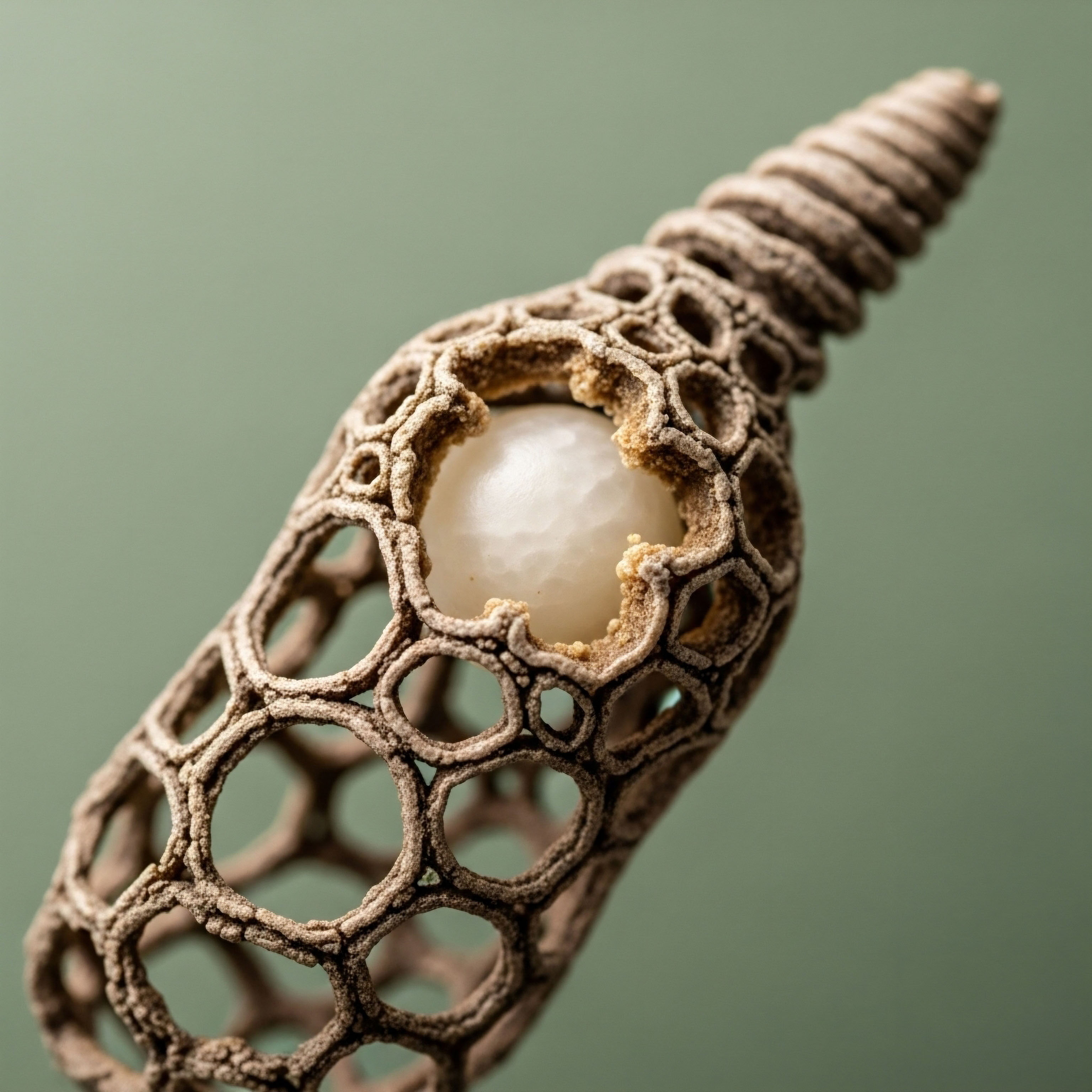

Fundamentals
You might feel it as a subtle shift in your body’s resilience, a change in how you recover from physical exertion, or perhaps you’ve noted fluctuations in your blood pressure readings. These experiences are tangible, real signals from your body’s intricate communication network.
At the heart of this network lies the dynamic behavior of your blood vessels, a concept known as vascular reactivity. This is the fundamental ability of your arteries to expand and contract, directing blood flow precisely where it’s needed, when it’s needed. This responsiveness is a cornerstone of cardiovascular health, ensuring your tissues receive the oxygen and nutrients required for optimal function, from your brain to your muscles.
Within the male physiological landscape, testosterone is often seen as the master hormone. Its role in building muscle, maintaining bone density, and supporting libido is well-established. Yet, a crucial biological process quietly converts a portion of this testosterone into estradiol, the most potent form of estrogen.
This conversion is facilitated by an enzyme called aromatase, which is active in various tissues, including fat, brain, and even the walls of your blood vessels. The presence of estrogen in the male body is a feature of a finely tuned system. This locally produced estradiol performs critical functions, one of the most important of which is modulating the health and reactivity of your vascular system.
The conversion of testosterone to estrogen is a vital biological process that directly supports the flexibility and health of male blood vessels.
The key to understanding this process lies with a remarkable signaling molecule ∞ nitric oxide (NO). Think of the inner lining of your blood vessels, the endothelium, as a highly intelligent, responsive surface. This endothelial layer acts as a gatekeeper, sensing the needs of the body and responding by releasing signals that instruct the surrounding smooth muscle of the artery to either relax or constrict.
Nitric oxide is the primary messenger for relaxation. When the endothelium releases NO, it signals the vascular smooth muscle to relax, causing the blood vessel to widen in a process called vasodilation. This widening lowers blood pressure and increases blood flow, delivering a surge of oxygenated blood to tissues that require it.
Estrogen acts as a powerful catalyst for this process. It directly stimulates the endothelial cells to produce and release more nitric oxide, enhancing the vessel’s ability to relax and respond efficiently to the body’s demands.

The Key Molecules in Male Vascular Health
Understanding the roles of the individual components clarifies the entire system. Each molecule has a distinct function, yet they operate in a coordinated fashion to maintain vascular equilibrium. Their interplay is a testament to the body’s inherent drive for balance and efficiency.
| Molecule | Primary Role in This Context | Source in Males |
|---|---|---|
| Testosterone | Serves as the precursor hormone for estradiol production. | Primarily the testes. |
| Aromatase | An enzyme that converts testosterone into estradiol. | Adipose tissue, brain, bone, and vascular walls. |
| Estradiol (Estrogen) | Signals the endothelium to increase nitric oxide production. | Conversion from testosterone via aromatase. |
| Nitric Oxide (NO) | The direct signaling molecule that causes vasodilation (blood vessel relaxation). | Produced by the endothelium upon stimulation by estrogen. |

Primary Vascular Benefits of Estrogen in Men
The influence of estrogen on the male vascular system is specific and profoundly beneficial. It orchestrates a series of events that collectively contribute to cardiovascular resilience and optimal circulatory function. These effects are foundational to long-term health.
- Enhanced Endothelial Function ∞ Estrogen directly supports the health of the endothelium, the critical inner lining of blood vessels, ensuring it can produce the signaling molecules necessary for vascular control.
- Increased Nitric Oxide Availability ∞ It upregulates the production of nitric oxide, the body’s most potent vasodilator, which allows arteries to relax and widen, improving blood flow and lowering pressure.
- Improved Vascular Reactivity ∞ By promoting nitric oxide synthesis, estrogen makes blood vessels more responsive and adaptable to the body’s changing circulatory needs, such as during exercise or stress.
- Antioxidant Properties ∞ Estrogen helps protect the vascular system by mitigating oxidative stress, which can damage endothelial cells and reduce the availability of nitric oxide.


Intermediate
To appreciate how estrogen modulates male vascular reactivity, we must examine the specific biological machinery it employs. The hormone exerts its influence through two distinct, yet complementary, pathways within the endothelial cells that line the arteries. These are the genomic and non-genomic pathways. Both converge on the same goal ∞ increasing the amount and activity of an enzyme called endothelial nitric oxide synthase (eNOS), the molecular factory responsible for producing nitric oxide.
The genomic pathway represents a long-term strategy for vascular maintenance. In this process, estrogen molecules travel into the nucleus of an endothelial cell and bind to a specific protein called an estrogen receptor, primarily Estrogen Receptor Alpha (ERα).
This binding event activates the receptor, causing it to attach to specific locations on the cell’s DNA known as Estrogen Response Elements (EREs). These EREs are located in the promoter region of the gene that codes for the eNOS enzyme.
By binding to the DNA, the activated receptor initiates the process of transcription, effectively telling the cell to create more eNOS protein. This leads to a sustained, higher capacity for nitric oxide production over time. It is a fundamental upregulation of the entire system, building a more robust infrastructure for vascular health.
The non-genomic pathway, in contrast, is a mechanism for rapid response. A subpopulation of estrogen receptors is located not in the nucleus, but embedded in the cell membrane, particularly in small invaginations called caveolae where they are physically close to eNOS enzymes.
When estrogen binds to these membrane-bound receptors, it triggers a rapid cascade of signaling events inside the cell. This cascade, primarily involving the PI3K/Akt signaling pathway, leads to the phosphorylation of the already-existing eNOS enzyme. Phosphorylation acts like a molecular switch, instantly activating the enzyme and causing a swift, immediate release of nitric oxide. This allows the blood vessel to respond in seconds to the presence of estrogen, providing a mechanism for acute adjustments in blood flow.

How Does Aromatase Inhibition Directly Impact Blood Flow?
Understanding these pathways clarifies the clinical observations in men undergoing certain hormonal therapies. For instance, in Testosterone Replacement Therapy (TRT), a primary goal is to restore testosterone to healthy physiological levels. However, this also increases the substrate available for the aromatase enzyme, potentially leading to elevated estradiol levels. To manage this, medications like Anastrozole, an aromatase inhibitor, are often prescribed. Anastrozole works by blocking the aromatase enzyme, thereby reducing the conversion of testosterone to estrogen.
The body’s regulation of vascular tone depends on a sophisticated dialogue between genomic and non-genomic hormonal signals.
While this can be effective for managing symptoms related to high estrogen, aggressive suppression of aromatase can have unintended consequences for vascular health. By severely limiting the production of estradiol, the body is deprived of a key signaling molecule for both the long-term genomic upregulation and the rapid non-genomic activation of eNOS.
The result is a reduction in basal nitric oxide availability and a blunting of the vessel’s ability to dilate in response to stimuli. Studies have demonstrated that administering an aromatase inhibitor to healthy men can lead to a measurable decrease in endothelial function, assessed by metrics like flow-mediated dilation (FMD) of the brachial artery.
This underscores the critical importance of maintaining a balanced Testosterone-to-Estradiol (T/E) ratio. The goal of hormonal optimization is to achieve a physiological balance that supports all bodily systems, including the vasculature, rather than simply maximizing one hormone at the expense of another.

The Stepwise Cascade of Estrogen-Mediated Vasodilation
The process from hormonal signal to physical response is a beautifully orchestrated sequence of molecular events. Each step builds upon the last, culminating in the relaxation of the blood vessel.
- Aromatization ∞ Testosterone circulating in the blood is taken up by tissues, including the vascular endothelium, where the aromatase enzyme converts it into 17β-estradiol.
- Receptor Binding ∞ The newly synthesized estradiol binds to Estrogen Receptor Alpha (ERα), both within the cell’s nucleus and on its membrane.
- Signal Transduction ∞ This binding triggers two simultaneous processes. The nuclear receptor promotes the long-term synthesis of more eNOS enzyme (genomic effect), while the membrane receptor initiates a rapid phosphorylation cascade (non-genomic effect).
- eNOS Activation ∞ The phosphorylation cascade instantly activates existing eNOS enzymes, while the genomic effect ensures a healthy supply of new enzymes is always available.
- Nitric Oxide Synthesis ∞ Activated eNOS utilizes the amino acid L-arginine as a substrate to produce nitric oxide (NO) and L-citrulline.
- Vascular Relaxation ∞ The newly produced NO, a gas, diffuses from the endothelial cell into the adjacent vascular smooth muscle cells. There, it activates an enzyme called guanylate cyclase, leading to the production of cyclic GMP (cGMP), which ultimately causes the muscle to relax.
- Functional Outcome ∞ The relaxation of the smooth muscle results in vasodilation, an increase in the artery’s diameter, which improves blood flow and reduces blood pressure.

Comparative Effects of Estrogen Status on Male Vascular Markers
The clinical status of estrogen levels has a direct and measurable impact on the markers of vascular health. This table summarizes the expected findings in different hormonal states, highlighting the importance of balance.
| Vascular Marker | Physiologically Balanced Estrogen | Suppressed Estrogen (e.g. High Aromatase Inhibition) |
|---|---|---|
| Flow-Mediated Dilation (FMD) | Optimal and responsive. Indicates healthy endothelial function. | Reduced or blunted. Indicates endothelial dysfunction. |
| Basal Nitric Oxide Levels | Normal to robust. Supports consistent vascular health. | Decreased. Leads to a more constricted vascular state. |
| eNOS Expression & Activity | Supported by both genomic and non-genomic pathways. | Downregulated due to lack of estrogenic stimulation. |
| Oxidative Stress | Lower. Estrogen provides an antioxidant effect. | Increased. Lack of estrogen removes a protective mechanism. |
| Blood Pressure | Tends to be well-regulated. | May increase due to higher peripheral vascular resistance. |


Academic
The regulation of vascular tone is a complex physiological process governed by a symphony of neural, humoral, and endothelial-derived factors. Within this intricate system, the role of sex steroids has been a subject of extensive investigation. In male physiology, estradiol, derived predominantly from the peripheral aromatization of testosterone, has been identified as a molecule of profound significance for cardiovascular homeostasis.
Its action on vascular reactivity is not a peripheral effect but a central mechanism for maintaining endothelial health and function. The primary effector of estrogen’s vasculoprotective properties is its ability to modulate the expression and activity of endothelial nitric oxide synthase (eNOS), the enzyme responsible for the synthesis of the potent vasodilator, nitric oxide (NO).

The Molecular Architecture of Estrogen Receptor Signaling in Endothelial Cells
The biological effects of estradiol are mediated through its interaction with specific intracellular receptors, principally Estrogen Receptor Alpha (ERα) and Estrogen Receptor Beta (ERβ). While both receptors are expressed in the vasculature, a compelling body of evidence from genetic knockout studies in animal models points to ERα as the predominant mediator of estrogen’s beneficial effects on the endothelium.
Male mice lacking the gene for ERα (ERα-knockout) exhibit significant endothelial dysfunction, appearing much like wild-type animals that have undergone gonadectomy, even with normal circulating testosterone levels. This highlights that it is the estrogenic signal, transduced through ERα, that is essential for maintaining vascular health.
The localization of ERα within the endothelial cell is dual ∞ it resides within the nucleus, where it functions as a classic ligand-activated transcription factor, and it is also found associated with the plasma membrane, particularly within specialized microdomains called caveolae, where it can initiate rapid, non-transcriptional signaling events.

Genomic Pathway Upregulation of eNOS Expression
The genomic, or transcriptional, regulation of eNOS by estrogen is a cornerstone of its long-term vasculoprotective effect. This pathway begins when a molecule of 17β-estradiol diffuses across the endothelial cell membrane and into the nucleus. There, it binds to the ligand-binding domain of a dormant, monomeric ERα.
This binding induces a critical conformational change in the receptor protein, causing it to dissociate from a complex of heat shock proteins that maintain its inactivity. The ligand-bound ERα then forms a homodimer with another activated ERα molecule. This ERα-ERα dimer is now transcriptionally competent. It scans the nuclear DNA for specific consensus sequences known as Estrogen Response Elements (EREs), with the canonical sequence being 5′-AGGTCAnnnTGACCT-3′.
The promoter region of the human eNOS gene (NOS3) contains sequences that function as EREs. Upon binding to these sites, the ERα dimer serves as an anchor point for the recruitment of a large multi-protein complex of co-activators. These co-activator proteins, such as those of the p160 family (e.g.
SRC-1, SRC-2) and histone acetyltransferases (HATs) like CBP/p300, are essential for remodeling the local chromatin structure. The HATs function by adding acetyl groups to the lysine residues of histone proteins, which neutralizes their positive charge and weakens their interaction with the negatively charged DNA backbone.
This process of histone acetylation leads to a more ‘open’ or decondensed chromatin configuration, known as euchromatin. This structural change makes the eNOS gene promoter accessible to the basal transcription machinery, including RNA polymerase II. The recruited co-activator complex then facilitates the assembly of the pre-initiation complex, leading to the initiation and elongation phases of gene transcription.
The result is an increased synthesis of eNOS messenger RNA (mRNA), which is subsequently translated into functional eNOS protein. This entire process unfolds over hours to days and results in a sustained elevation of the endothelial cell’s capacity to generate nitric oxide.

Nongenomic Pathway Rapid Activation of eNOS
Complementing the genomic pathway is a non-transcriptional mechanism that allows for the immediate activation of eNOS. This rapid signaling is initiated by a distinct pool of ERα localized to caveolae in the endothelial cell membrane. Caveolae are flask-shaped invaginations of the plasma membrane that are rich in cholesterol, sphingolipids, and the structural protein caveolin-1 (Cav-1).
Within these microdomains, ERα is physically coupled to a variety of signaling partners, including eNOS itself and the regulatory subunit of phosphatidylinositol 3-kinase (PI3K). In the basal state, eNOS activity is tonically inhibited by its direct binding to caveolin-1.
Upon the binding of estradiol to this membrane-associated ERα, a rapid conformational change is induced that disrupts the inhibitory eNOS-Cav-1 interaction. Simultaneously, the activated ERα engages and activates the associated PI3K. Activated PI3K then catalyzes the phosphorylation of phosphatidylinositol (4,5)-bisphosphate (PIP2) to phosphatidylinositol (3,4,5)-trisphosphate (PIP3) at the inner leaflet of the plasma membrane.
PIP3 serves as a docking site for proteins containing a pleckstrin homology (PH) domain, such as the serine/threonine kinase Akt (also known as Protein Kinase B). The recruitment of Akt to the membrane facilitates its phosphorylation and activation by other kinases, such as PDK1.
Activated Akt then directly phosphorylates the eNOS enzyme at a key regulatory serine residue, Serine 1177 (in human eNOS). Phosphorylation at this site causes a conformational change in the eNOS protein that greatly increases its enzymatic activity by enhancing the electron flux from its reductase domain to its oxygenase domain. This entire cascade, from estrogen binding to NO release, occurs within seconds to minutes, providing a powerful mechanism for acute physiological regulation of vascular tone.
The dual genomic and non-genomic actions of estrogen provide both long-term structural support and immediate functional control over vascular nitric oxide production.

What Is the Interplay between Androgens and Estrogens in Vascular Tone?
The regulation of vascular tone in males is not a function of androgens or estrogens in isolation, but rather a result of the dynamic interplay and metabolic relationship between them. The prevailing physiological model posits that while testosterone provides the necessary androgenic signals for many male characteristics, its conversion to estradiol via the aromatase enzyme is a critical step for maintaining cardiovascular health.
The Testosterone/Estradiol (T/E) ratio is therefore a more salient indicator of vascular status than the absolute level of either hormone alone. Evidence from both animal models and human clinical studies provides robust support for this concept.
Aromatase knockout (ArKO) mice have been an invaluable tool in dissecting these relationships. ArKO male mice are genetically incapable of producing estrogen. Despite having normal or even elevated levels of testosterone, these animals exhibit profound endothelial dysfunction, impaired vasodilation, and an atherogenic lipid profile.
Their vascular phenotype closely resembles that of ovariectomized females or ERα-knockout males. Crucially, administration of exogenous estradiol to these ArKO mice can rescue the vascular phenotype and restore normal endothelial function. This demonstrates unequivocally that it is the presence of estrogen, derived from testosterone, that is necessary for vascular protection, and that testosterone itself cannot substitute for this function.
Human studies corroborate these findings. Clinical trials involving the administration of potent aromatase inhibitors to healthy eugonadal men have consistently shown a significant impairment of endothelial function. Flow-mediated dilation (FMD), a non-invasive ultrasound technique that measures the NO-dependent dilation of the brachial artery in response to a shear stress stimulus, is significantly reduced after several weeks of aromatase inhibition.
This reduction in FMD occurs in parallel with a sharp decline in circulating estradiol levels, while testosterone levels often rise. This clinical model effectively decouples the effects of testosterone and estrogen, providing strong evidence that the estrogen component is indispensable for normal vascular reactivity in men.

Clinical Pathophysiology Estrogen and Endothelial Dysfunction
Endothelial dysfunction is recognized as an early event in the pathogenesis of atherosclerosis and a predictor of future adverse cardiovascular events. It is characterized by a shift in the endothelial phenotype towards a state of reduced vasodilation, increased inflammation, and pro-thrombotic activity.
A key feature of this dysfunctional state is a marked reduction in the bioavailability of nitric oxide. This can result from either decreased eNOS expression/activity or increased degradation of NO by reactive oxygen species (ROS), particularly the superoxide anion (O2•−).
Estrogen deficiency, whether induced pharmacologically in men or occurring naturally post-menopause in women, contributes directly to this pathophysiology. The absence of estrogenic stimulation on the eNOS system leads to both lower basal production of NO and a blunted response to vasodilatory stimuli. Furthermore, estrogen has direct antioxidant properties.
It can scavenge free radicals and also upregulate the expression of key antioxidant enzymes, such as superoxide dismutase (SOD). In an estrogen-deficient state, endothelial cells are more vulnerable to oxidative stress. Increased levels of superoxide anion react rapidly with nitric oxide in a diffusion-limited reaction to form peroxynitrite (ONOO−), a highly reactive and damaging oxidant.
This reaction not only consumes and inactivates NO, effectively “stealing” it from its vasodilatory pathway, but peroxynitrite itself can cause further cellular damage. It can oxidize lipids, damage DNA, and, critically, it can oxidize tetrahydrobiopterin (BH4), an essential cofactor for the eNOS enzyme.
When BH4 levels are depleted, the eNOS enzyme becomes “uncoupled,” and instead of producing nitric oxide, it begins to produce more superoxide anion, thus creating a vicious cycle of oxidative stress and endothelial dysfunction. Therefore, the protective role of estrogen in the male vasculature is twofold ∞ it actively promotes NO synthesis while simultaneously protecting the endothelial environment from the oxidative forces that would otherwise diminish NO bioavailability.

References
- Chambliss, Kenneth L. and Philip W. Shaul. “Estrogen modulation of endothelial nitric oxide synthase.” Endocrine reviews 23.5 (2002) ∞ 665-686.
- Sader, M. A. and D. S. Celermajer. “Endothelial function, vascular reactivity and gender.” Canadian Journal of Cardiology 18.3 (2002) ∞ 267-273.
- New, G. et al. “Long-term estrogen therapy improves vascular function in male to female transsexuals.” Journal of the American College of Cardiology 29.7 (1997) ∞ 1437-1444.
- Sudhir, Krishnankutty, et al. “Estrogen enhances basal nitric oxide release in the forearm vasculature in postmenopausal women.” Hypertension 28.3 (1996) ∞ 330-334.
- Mendelsohn, Michael E. and Richard H. Karas. “The protective effects of estrogen on the cardiovascular system.” New England Journal of Medicine 340.23 (1999) ∞ 1801-1811.
- Hayashi, T. et al. “17ß-estradiol inhibitslicaused by oxidized low density lipoprotein.” Circulation 92.1 (1995) ∞ I-521.
- White, Richard E. James N. Buchholz, and Michael J. Wargovich. “Hormonal modulation of endothelial NO production.” Vascular Pharmacology 46.4 (2007) ∞ 239-247.
- Geary, G. G. D. N. Krause, and S. P. Duckles. “Estrogen reduces myogenic tone through a nitric oxide-dependent mechanism in rat cerebral arteries.” American Journal of Physiology-Heart and Circulatory Physiology 275.1 (1998) ∞ H292-H300.
- Iorga, Andrea, et al. “The protective role of estrogen and estrogen receptors in cardiovascular disease and the controversial use of estrogen therapy.” Biology of sex differences 8.1 (2017) ∞ 1-16.
- Faria, Jose, et al. “The role of estradiol in the regulation of vascular endothelial and smooth muscle cell function.” Maturitas 67.1 (2010) ∞ 13-19.

Reflection
You have now journeyed through the intricate molecular pathways that connect your hormonal status to the physical reality of your circulation. This knowledge is a powerful tool. It transforms the abstract feeling of well-being into a series of understandable biological processes. Consider for a moment the signals your own body provides.
Think about your energy, your blood pressure, your physical performance. How might these experiences be connected to the delicate balance of hormones we have discussed? Understanding the ‘why’ behind these systems is the first and most critical step. This information empowers you to ask more precise questions and to engage in a more meaningful dialogue about your health.
The path forward is one of continued learning and proactive partnership, using this foundational knowledge to build a personalized strategy for lifelong vitality.

Glossary

blood pressure

vascular reactivity

your blood vessels

estradiol

aromatase

nitric oxide

vasodilation

endothelial cells

endothelial function

oxidative stress

endothelial nitric oxide synthase

estrogen receptor alpha

estrogen receptor

nitric oxide production

vascular health

caveolae

aromatase enzyme

anastrozole

flow-mediated dilation

vascular tone

endothelial nitric oxide




